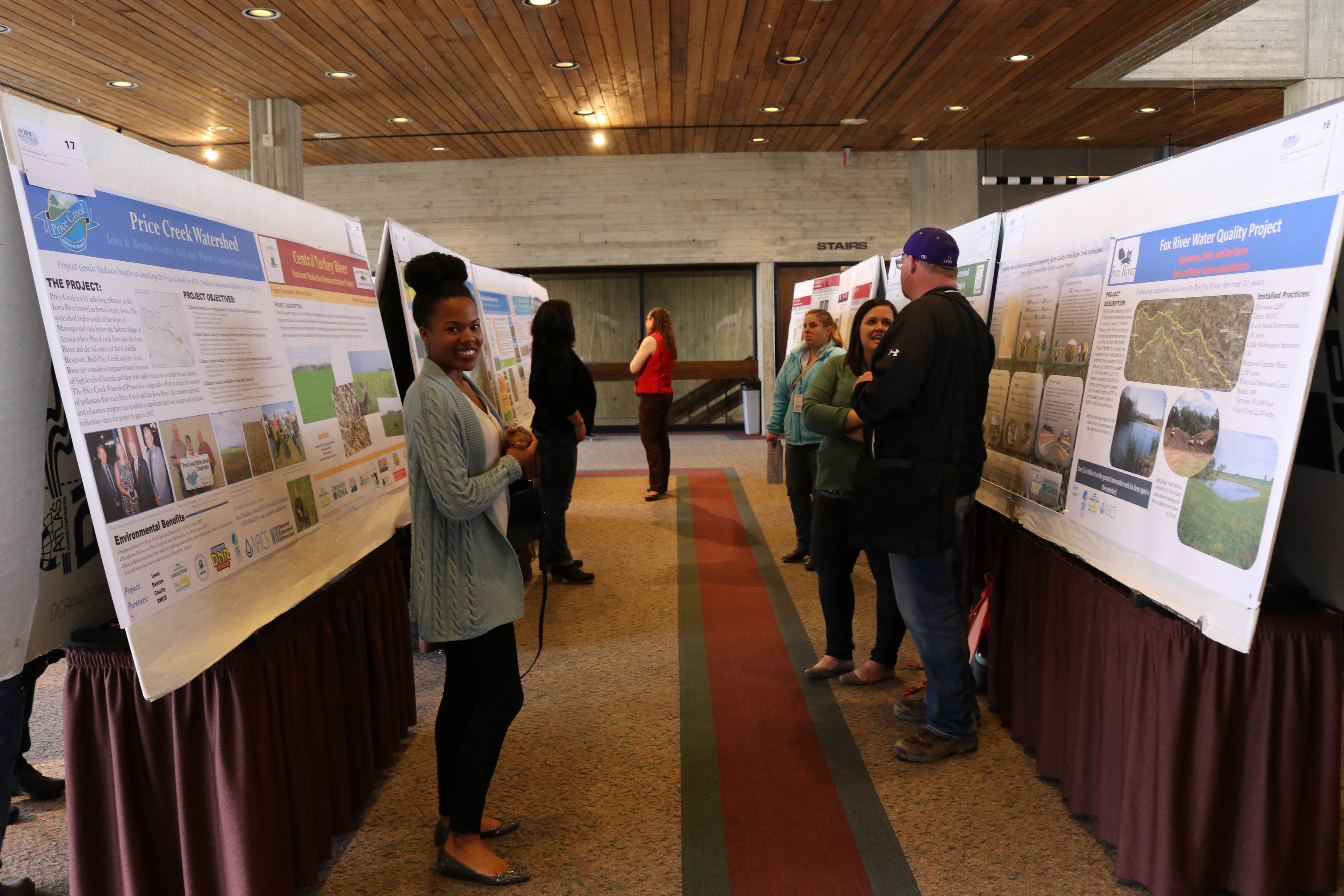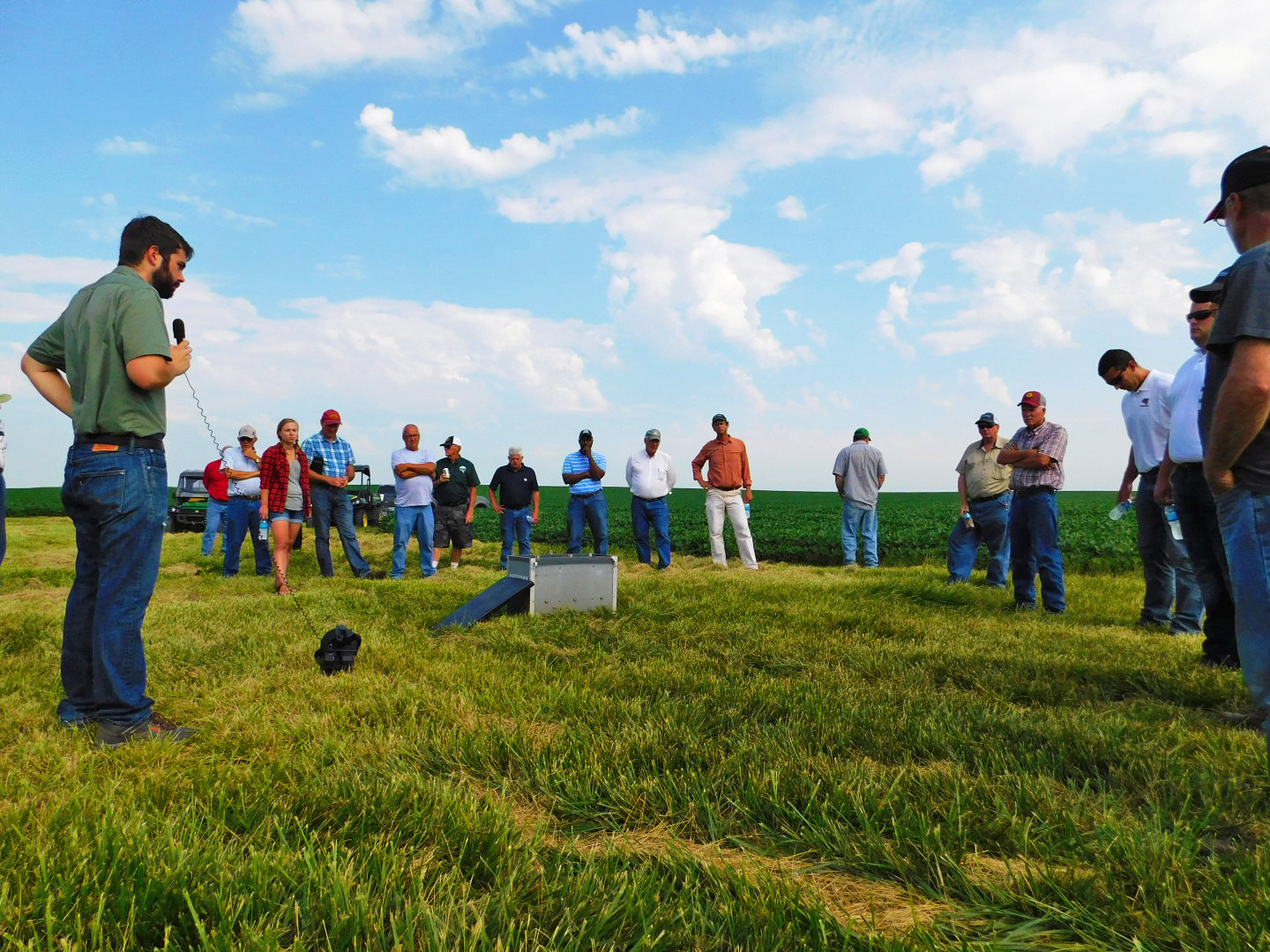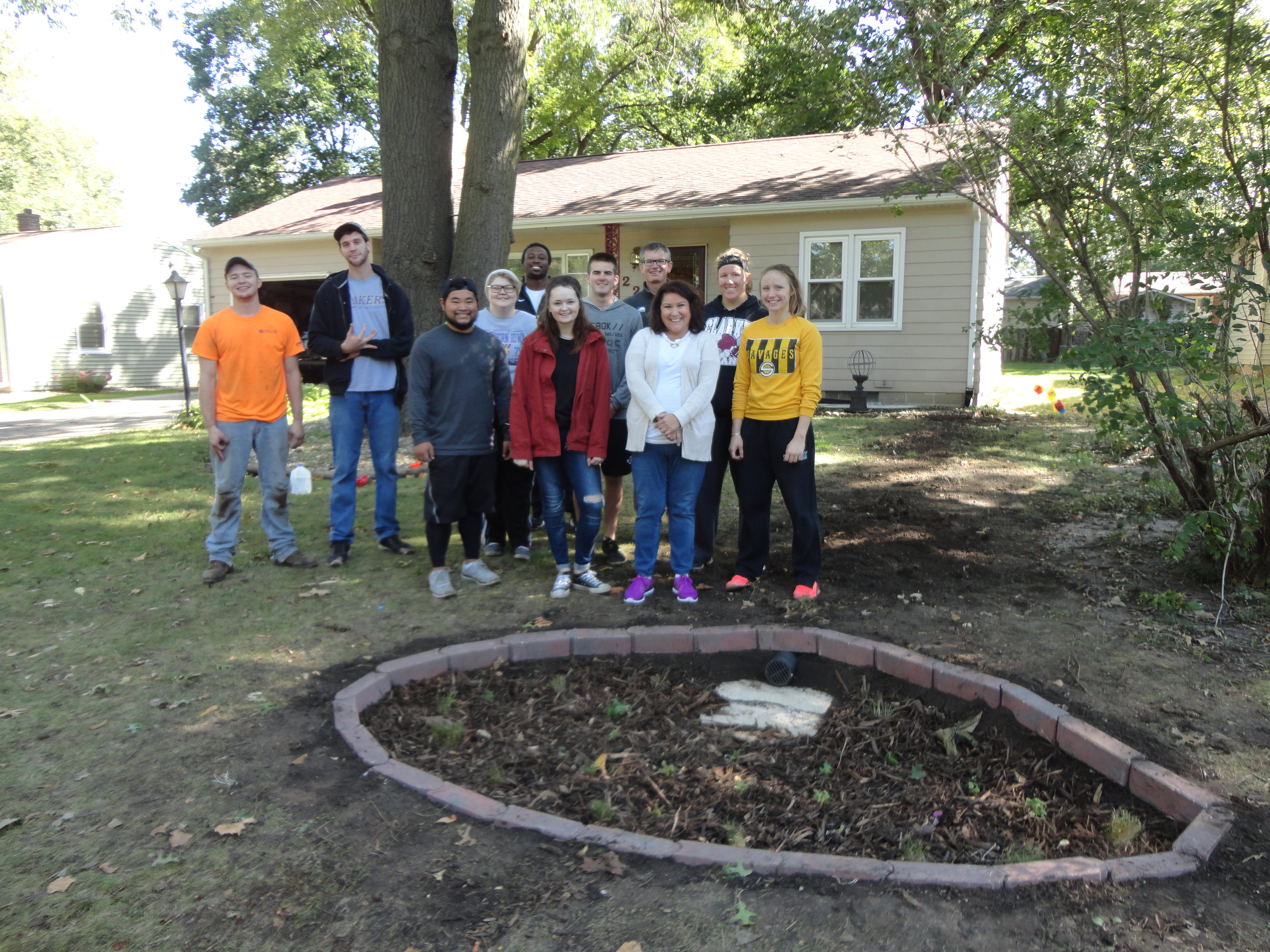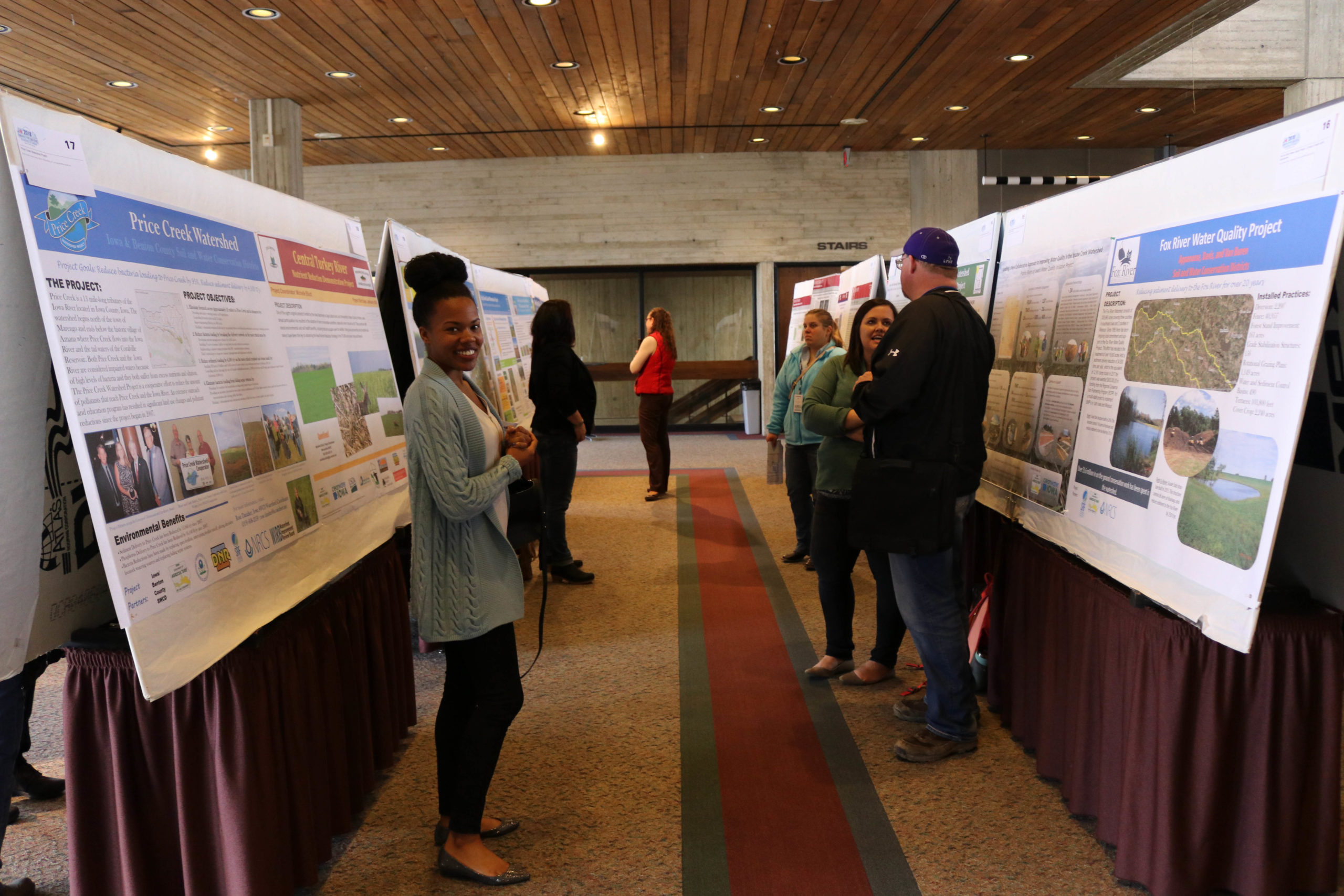Rick Cruse, Professor in the Agronomy Department at Iowa State University and Director of the Iowa Water Center, has a deep appreciation for a resilient outdoor world that energizes his soils research and graduate teaching activities.
Continue readingWorking with Nature!
From Iowa Learning Farms
I spent this summer traveling to field days around Iowa as well as driving back from our American Society of Agricultural and Biological Engineers (ASABE) annual meeting in Detroit, Michigan. One of my purposes in attending the ASABE meeting was to accept for the team the Blue Ribbon Award in the Educational Aids Competition for our revised version of the Water Rocks! Rock Your Watershed! online game (read more about it in our previous post Water Rocks! Brings Home a Blue Ribbon). Part of our revisions included adding more diversity to the land management choices that players can make and clearly showing the environmental benefits of diversifying our watersheds. Driving around the Midwest and Iowa really brought home to me how important this is and how far we need to go to still achieve the kind of diversity that will make a difference.
But last week I traveled to the Iowa Great Lakes area for a field day and then stayed up there for some vacation time with my family. The field day near West Okoboji Lake focused on prairie and wetland restoration to clean the water before it enters the lake. The side benefit would be increases in wildlife including pollinators of all sorts. The next day we visited our prairie strips site that is directly east of Big Spirit that was installed a few years ago for the same purpose of protecting local water quality and increasing habitat. In both cases, local stakeholders came together to diversify the land to help protect a local asset. I could hear the pride in their voices when discussing the changes they had put into place.
 I am an engineer and spend a lot of time writing and talking about new technology. However, this summer really highlighted to me that many of our fixes cannot be solved by technology alone. Instead, we need to strategically restore or implement more diverse natural systems where they can do the most good in terms of water quality, wildlife and overall land health. We are able to do these practices such as prairie strips and wetlands by combining technological advances with a solid understanding of the natural ecological system that was replaced with row crop agriculture and other development. Modern technology helps us know where to place the natural system for the greatest benefit. After that, the natural system will do all the work.
I am an engineer and spend a lot of time writing and talking about new technology. However, this summer really highlighted to me that many of our fixes cannot be solved by technology alone. Instead, we need to strategically restore or implement more diverse natural systems where they can do the most good in terms of water quality, wildlife and overall land health. We are able to do these practices such as prairie strips and wetlands by combining technological advances with a solid understanding of the natural ecological system that was replaced with row crop agriculture and other development. Modern technology helps us know where to place the natural system for the greatest benefit. After that, the natural system will do all the work.
Both of the restored areas I visited near the Iowa Great Lakes are less than five years old. The local folks are doing a good job of ensuring diversity in the perennial plantings. I have seen other areas in Iowa under perennial vegetation that opted for monoculture grasses, mainly cool-season grasses. While the diverse native prairie restorations are more challenging to manage, the beauty alone makes it worth it to me. Factor in water quality, wildlife and land health benefits and it is a home run.
If this is something that interests you for the land you own or manage, there is assistance and information available to you. We are really fortunate in Iowa to have organizations such as the Tallgrass Prairie Center that have spent years figuring out how to support landowners in planting and managing prairie restoration on the land. For my part, I am going to continue to work to understand how to best manage these systems and what technology is needed to allow diversity to flourish. I would encourage you to go online to www.waterrocks.org and play the Rock Your Watershed! game to learn how we can work with better with the natural systems.
And also, take some time to find those natural areas around you and think about how we can use natural systems such as wetlands, prairie strips, oxbow restoration, riparian buffers, and others to help clean our water, diversify our landscapes, increase wildlife and enhance the beauty on the land. I know I felt a little “restored” after my time in these natural settings.
Note from the Iowa Water Center: Have a story to tell about bringing the land back to basics? Submit an abstract to the 2019 Iowa Water Conference
The Death and Life of the Great Lakes–Book Review
Post written by Hanna Bates, Program Coordinator for the Iowa Water Center
I remember the first time I visited one of the Great Lakes. I was 14-years-old on a family vacation to Chicago, Illinois. Like everyone who goes to the Windy City, I took a trip up the 100-story John Hancock Tower in an ear-popping elevator to the observatory deck to look out on to the expanse of the city as well as the endless blue of Lake Michigan that expanded for miles and miles. To me, it was like seeing the ocean. What I didn’t know at the time was that I was indeed, seeing a little bit of the saltwater seas because invasive species have been carried along with cargo ships from around the world and released them into the lakes. For years, their presence has been disrupting the aquatic ecosystem and destroying native species. These processes of changing ecological habitats were spurred by short-sighted policies and a race to compete in a global economy.
In Dan Egan’s The Death and Life of the Great Lakes, decades-long investigative reporting for the Milwaukee Journal Sentinel has culminated into a book that reveals how the Great Lakes changed over time for the worse. This evolution was created by changes in the hydrology to accommodate the shipping industry and the varied approaches to natural resource management to remediate the unending cycle of invasive species. From lampreys, that act as vampires of the sea who drain life from native species, to pipe-clogging mussels, the Great Lakes’ aquatic ecosystem and those who use its resources for fishing, recreation, and shipping commerce have had many problems to contend with throughout the last century.
The bulk of the book serves as a historical review of the reoccurrence of invasive species that cost lake managers, coastal municipalities, and fishermen billions of dollars. This started with a major event – the adaptation of the St. Lawrence Seaway to be a navigable water for cargo ships for seaway commerce and the belief that the canal could compete with other global river highways. Although the Great Lakes naturally flow to the Atlantic Ocean, invasive species have found their way against the current of the channel by hitching a ride on ships either on deck or below in ballast water, which is water stored on a ship to maintain stability in choppy waters and unfavorable weather. Ships carry sea water into the Great Lakes and then discharge millions upon millions of gallons of this water into Great Lakes ecosystem that carry bacteria, plant life, and fish organisms. Invasive species that have phased through the lakes during the last century include Lampreys, Alewives, Zebra and Quagga mussels, and Carp. The invasive species started killing the top of the food chain in the lakes, but newer invasive species started to do something more dangerous to the ecosystem, according to Egan. They began to consume vast quantities of bacteria and algae that form the entire foundation of aquatic ecosystems, which creates a ripple effect to larger aquatic life in the lake.
Egan’s book includes many notable stories of municipalities and agencies who changed watershed hydrology to solve short-term problems for urban development and expansion. In doing so, they created long-term negative impacts on regional natural system. Originally, problems within the lakes were sealed from the rest of the US. They were isolated from regions like the Mississippi River Basin where 31 states rely on riparian systems for fishing, recreation, and public drinking water. In 1900, the City of Chicago reversed the flow of the Chicago River to no longer exit in Lake Michigan. Rather, it was routed to drain into the Des Plaines River that leads to the Mississippi River. The purpose of this was to not only find a new route for the Chicago sewage system to flow, but to also prevent flooding in urban areas next to Lake Michigan. Doing so opened up the maelstrom in the lakes to the entire Mississippi River system. In my own further research after reading Egan’s book, species such as Zebra Mussels and Asian Carp are present in Iowa, according to the Iowa Great Lakes Association (Iowa Great Lakes Association 2018).
I highly recommend this book for water professionals and the layperson who wants to know the risk nonnative species pose to our water system and the history of our evolving waterscapes in the U.S. Not only this, but Egan also describes water access in an age of climate change where cities across the US are running low on water supplies.
Overall, The Death and Life of the Great Lakes demonstrates that local changes can have regional impacts to those who do not always get a say in the matter, such as those in Toledo, Ohio or downstream on the Colorado River. During a PBS New Hour Interview, Dan Egan states that it’s not likely that we can ever restore the lakes back to what they used to be before their use as riparian highways for goods. Rather, we should better appreciate the majesty of the lakes as well as approach our relationship with the lake with more humility when it comes to natural resource management.
References:
Iowa Great Lakes Association. 2018. Fish Barrier/Asian Carp. Web accessed: https://iagreatlakes.com/category/fish-barrierasian-carp/
Long-term crop rotation and tillage effects on soil greenhouse gas emissions and crop production Illinois, USA (Research Summary)
Post submitted by Tianna Griffin, the Iowa Water Center’s Special Projects Assistant
A recent article by Behnke et al. (2018) evaluates the long-term effects of crop rotation and tillage practices on yield and greenhouse gas emission for corn (C), soybeans (S), and wheat (W). The rotations were CCC, CS, CSW, SSS, SC, WCS, with each rotation representing one year. Each rotation had a tilled (T) and no-till (NT) treatment. The study was conducted using a 15-year time span at the Northwestern Illinois Agricultural Research and Demonstration Center.
Behnke, et al’s research evaluated tillage practices and crop rotation on yield, greenhouse gas emission, and soil available Nitrogen (N). Behnke et al. hypothesized that crop rotations where less N fertilizer is used would result in lower greenhouse gas emissions, specifically nitrous oxide (N2O). They predicted that chisel tillage would cause an increase in N2O and CO2 (carbon dioxide) emissions caused by mineralization of decomposing residues (Behnke, et al 2018). From 2012-2015, greenhouse gas emissions were taken weekly during a period of four growing seasons. The data was grouped into three sets of sampling months: March-May, June-August, and September-November. Putting the data into groups allowed for analysis of seasonality on greenhouse gas emission. Soil samples were also taken from the 2013-2015 growing year to evaluate N concentrations.
A main finding of the study was that there wasn’t a significant difference on greenhouse gas emissions between continuous corn with tillage and continuous corn with no till. They found that there was a significant benefit of chisel tillage to corn and soybean yield in increasing organic matter and residue, but there was no increase of N2O and CO2 in the soil found in the study. Because corn typically benefits from high amounts of N, they observed that corn being part of a rotation was able to lower the amount of N2O in the soil. An important part of the research was that N2O emissions were higher at times of fertilizer application. During fertilizer application is when pollution (water and air) is more likely to occur. When fertilizer is applied in excess, plants don’t take up all of it; what is not taken up by the plant is volatilized (when a chemical converts to a liquid or gas) and/or runs off the field. Yields were higher with a diverse crop rotation, such as CS or CSW. Having a diverse cropping system also provides resiliency in yield during suboptimal weather conditions.
Agricultural practices are responsible for a lot of the pollution that occurs in the United States. According to Behnke et al. (2018), greenhouse gases emissions due to agricultural practices in the Unites States makes up 9% of the emitted greenhouse gases. Of that 9%, 81% is CO2, 11% is NH4 (methane), and 6% is N2O. Long-term research like this study can help evaluate ways to mitigate greenhouse gas emissions as well as determine the effects of some agricultural practices on greenhouse gas emissions as well as on improving yields. This research may lead to more long-term research on agricultural practices.

Tianna Griffin was the Iowa Water Center’s Special Projects Assistant. She recently graduated with an undergraduate degree in agronomy with emphasis in agroecology and and a minor in horticulture with an emphasis in fruit and vegetable production.
Why I am Getting into Soil and Water
Post submitted by Lindsay Brown, recent graduate from Iowa State University and member of Iowa State’s Soil and Water Conservation Club (SWCC)
My name is Lindsay Brown and I have recently graduated Iowa State University with a Bachelor of Science Degree in Biology and Environmental Science. I joined the Soil and Water Conservation Club (SWCC) in the fall semester of 2016 and it has provided me with vast amounts of knowledge surrounding the topic of soil and water conservation. Over the years I have heard many presentations from graduate students, professors and other professionals working in the field. The presentations range from land management and conservation to farming practices. Hearing from these various professionals has allowed me to diversify my knowledge about these topics and develop a better understanding on how conservation efforts can be implemented and managed. The SWCC does not only meet every other week and listen to presentations, but we also sell, assemble and present Groundwater Flow Models. These models visually represent how water moves throughout the ground. This visualization can help students, farmers, faculty, or really anyone to realize the importance of water movement on the surface and underground and how understanding its movement can lead to specific water management practices. The Groundwater Flow Models are sold and distributed nationally and internationally and the profits go toward club funds, which allows us to go on trips and attend conferences for professional experience.
The SWCC also has an annual publication called Getting into Soil and Water that is put together by the publication committee. Getting into Soil and Water is a publication that is composed of a variety of articles related to soil and water about local and international subjects written by professionals from various backgrounds. I have been an editor for this publication since August of 2016 and have learned a lot about the editing process, leadership skills, and how to communicate efficiently and effectively with my peers, authors and sponsors. At the beginning of the year, the publication committee discusses and brainstorms different possibilities for themes the publication could follow. After the theme is discussed and we’ve reached a consensus, authors are then contacted to see if they would like to write an article in the publication. After all the articles are retrieved, the editing process begins. Each article is edited many times by each member of the committee and compiled into a cohesive publication. Once the publications are printed, they are distributed to people all around the state of Iowa. Through my experience of being an editor, I learned how to delegate effectively and to recognize the value each person brings to a team in achieving a larger goal. Being an editor also gave me experience running meetings, helped me to develop confidence voicing my opinions in a group setting and allowed me to share ideas with my peers in the publication committee. All of these experiences will be useful for my future career goals and aspirations.
Since graduation I have moved to Minneapolis and now have an internship with the University of Minnesota partnered with the City of Woodbury leading a water conservation project. My future career goals are to work with environmental consulting to decrease environmental degradation and improve the health of communities and ecosystems. Being a part of the SWCC and the Getting into Soil and Water publication committee as an editor, has provided me with multiple years of experience learning about conservation practices as well as practical communication skills. I would definitely recommend students to get involved in student organizations like the SWCC on campus, because it provides you with lifelong practical skills for your future career.
Lindsay Brown is leading a water conservation project with the Minnesota Technical Assistance Program in Minneapolis, Minnesota. She has a B.S. in Biology and Environmental Science from Iowa State University. She is currently looking for full-time employment doing environmental consulting in the Twin Cities area.
Reflecting on the Iowa Water Center

[Editor’s Note: We would like to thank Tianna for all of her hard work while at the Iowa Water Center. We wish her the best on her next endeavors!]
Post submitted by Tianna Griffin, the Iowa Water Center’s Special Projects Assistant
As my time with the Iowa Water Center comes to an end, I would like to reflect on my experience. I have enjoyed working with and getting to know Hanna, Melissa, and Rick. I have learned skills that will stick with me on my future endeavors. Starting at IWC I had goals to learn more about water related issues and to improve my writing skills, and I was able to accomplish both of those.
Working at IWC was different than any job that I had. Prior to IWC, most of my job experience was working with plants directly. As Special Projects Assistant, I spent a lot of time on a computer doing various projects related to water issues. One of my favorite yet most challenging projects was summarizing scientific articles. I am glad to have gained this skill because it helped me to figure out how to read more challenging literature, process the information and summarize it.
Working at IWC I learned a lot about watersheds and what people are doing to improve Iowa’s waters. Getting a glimpse from behind the scenes on the communication and challenges that goes into making a change in Iowa’s waters was by far my favorite part of my job. I admire the different ways that IWC does to educate, communicate, and organize with other organizations to make a difference. My time at IWC has opened my eyes to the issues and challenges Iowa faces with water. As my experiences grow, I hope to one day make a difference with issues that face water and/or agriculture like IWC.
Now that I have graduated, I will be moving on to work at a greenhouse in North Carolina as an Assistant Greenhouse Grower where I will work with ornamentals. I can only hope to continue to gain new knowledge and experiences to find my niche.
Tianna
Tianna Griffin was the Iowa Water Center’s Special Projects Assistant. She recently graduated with an undergraduate degree in agronomy with emphasis in agroecology and and a minor in horticulture with an emphasis in fruit and vegetable production.
2018 Practical Farmers of Iowa Annual Conference
Post submitted by Tianna Griffin, the Iowa Water Center’s Special Projects Assistant
Practical Farmers of Iowa (PFI) 2018 Annual Conference was an event that brought families, farmers and professionals together to learn and meet new people. It was my first time attending a conference and it won’t be my last.
The event was from January 18-20th and there were approximately 1,000 people who attended. This conference opens the opportunity for students, farmers, professors, and professionals in natural sciences to come together to learn new things and network. The conference theme was “Revival.” As the conference program stated, “At Practical Farmers, we believe that revival – of rural communities; of our soil, creeks and rivers; of opportunities for young people to set down roots where they grew up – is vital for agriculture, people and the land.” The topics presented, and the overall dynamics of the event exceeded my expectations. I didn’t know what to expect attending a conference; there were more people there than I expected, it was a family oriented event, and the set-up was conducive to interacting with others.
The event was filled with friendly and professional people. I saw many familiar and new faces. There was a wide variety of exhibitors to network with who specialized in animal feed, tillage practices, organic production, and many more. A silent auction was held, and sessions to attend ranging from, “Teaching Livestock to Eat Weeds,” “Pragmatic Approaches to Sustainability and Profitability,” “Leaving Your Legacy,” and many more. There were two sessions on Friday, and five sessions on Saturday that were 70 minutes long. The presenters were a diverse set of people who were farmers that grow row crops as well as horticultural crops. There were ISU professors, as well as professionals who had expertise in certain areas of agriculture. This was the most impressive aspect of the conference because it allowed for a variety of available sessions. It allowed me to step out of my comfort zone of attending more than just topics on horticulture crops (which is my academic minor) and attend sessions that I otherwise wouldn’t have had the opportunity to attend.
Some sessions that I attended and enjoyed were “Ecology and Management of Iowa’s Common Vegetable Insect Pests” presented by Dr. Donald Lewis who is an ISU entomologist, “Learning from On-Farm Research: Horticulture,” presented by Carmen Black, Rob Faux, and Liz Kolbe. Black and Faux are growers who practice on-farm research. Lastly, “Using Tea Bags to Assess Soil: A Low-Cost Approach?” presented by Marshall McDaniel who is an assistant professor at ISU in agronomy. I learned many new things by attending the conference as well as got a refresher on things of which I already had knowledge. There were so many good topics being presented that I didn’t know what to choose.
I enjoyed going to the PFI Annual Conference. It was a successful event because they represent people with different backgrounds of expertise; professionals and families attended the event. Because there’s a variety of different speakers it allows for the opportunity to learn new things and meet new people. Events like the PFI Annual Conference makes the possibility of their conference theme “Revival” come true by bringing farmers and town people together. According to PFI’s conference website, by “Revival,” PFI envisions repopulating rural areas with farmers, regenerating Iowa soils by diversifying crop rotations, rejuvenating creeks and rivers, and opening opportunities for the next generation of farmers.
 Tianna Griffin is Iowa Water Center’s Special Projects Assistant. She is pursuing an undergraduate degree in agronomy with emphasis in agroecology and minoring in horticulture with an emphasis in fruit and vegetable production.
Tianna Griffin is Iowa Water Center’s Special Projects Assistant. She is pursuing an undergraduate degree in agronomy with emphasis in agroecology and minoring in horticulture with an emphasis in fruit and vegetable production.
Forming Successful Partnerships: Connecting Water Quality and Communities for the Benefit of All

Post submitted by Josh Balk, Dry Run Creek Watershed Improvement Project Coordinator, and Shane Wulf, Miller Creek Water Quality Improvement Project Coordinator.
In an ever-changing environmental landscape with increasing demands, tighter budgets, and a sense of uncertainty, partnerships are essential to provide resiliency for any water quality effort. Whether a watershed project, a community organization, or just an enthusiastic individual, creating collaborative initiatives can provide support to help weather any storm. Although requiring an initial investment on the front end to get set up, the long-term benefits of having partners to rely on and bring resources to the table should be justifiable. Identifying partners is indeed the first task, which can be daunting in itself. Every community is different and being able to recognize the local resources available is a skill. Once identified, nurturing these relationships to continue being successful is even more important. Ensuring that there is some form of mutually beneficial exchange will help all parties feel active, engaged, and remain involved. Whether it’s looking for matching funds, education and outreach, volunteers, or expanding support, partnerships can add a lot of value in to initiatives. Getting creative with partnered projects can help to hit untapped audiences and help an initiative stand out in the crowd.

The Black Hawk Soil and Water Conservation District has two watershed projects coming at water quality improvement efforts from different angles. This has included recognizing the local concerns and utilizing the resources available to each of their benefit. The Miller Creek Water Quality Improvement Project has formed many successful partnerships working with regional, state, and federal agencies as well as commodity groups. Two prime examples include the Middle Cedar Partnership and Midwest Agriculture Water Quality Partnership RCPP projects. These projects include several partners spanning from the City of Cedar Rapids, the Sand County Foundation, the Iowa Department of Agriculture, and many others. Together, these projects provide federal funding for conservation efforts in addition to Miller Creek WQI practice dollars. In 2017, the Miller Creek Project experienced high cost-share demand resulting in a $27,000 practice deficit. In response to this demand, Black Hawk SWCD and Iowa Agriculture Water Alliance (IAWA) formed the Miller Creek Challenge. Providing a $13,500 grant, IAWA challenged the Black Hawk SWCD to raise the remaining funds. With anticipation of a repeat experience, the Black Hawk SWCD increased their goal to raising $100,000 and are currently fundraising with private citizens, businesses and many organizations. These efforts have helped Miller Creek to bring in many additional funds to help improve water quality.
On the other end of the spectrum, the Dry Run Creek watershed is about 44% urban with a large residential population of Cedar Falls having a direct impact on the stream. The Dry Run Creek Watershed Improvement Project has focused a large effort towards partnerships involving the local educational systems to find enthusiastic volunteers passionate about water quality. This has involved students in kindergartners all the way up to seniors in college. Efforts have included rain garden installations, conservation book publishing, stream assessments, water monitoring efforts, outreach events, and educational materials just to name a few. These have all helped Dry Run Creek to succeed in its goals while also drumming up community awareness and support, two essential features for any watershed project.
Given the theme for this year’s Water Conference, ‘Our Watershed, Our Community’, the goal of this presentation will provide valuable insight in to the connection between the two. We are very excited for this opportunity to share our successes so that others may expand upon their networks for the benefit of water quality in Iowa.
Josh Balk has been the Dry Run Creek Watershed Improvement Project Coordinator for three years. He received his B.A. in Earth Science from the University of Northern Iowa.
Shane Wulf has been the Miller Creek Water Quality Improvement Project Coordinator for 4 years. He received his B.S. in Geography with a Geology Emphasis from the University of Wisconsin-Whitewater.
What we can learn when we come together
Post written by Hanna Bates, Program Assistant at the Iowa Water Center
The agriculture community is a vast network that includes farmers, researchers, coordinators, agronomists, and more. Whether we are in the lab or out in the field, we all have one person in common – the farmer. According to a study by Doll and Reimer in the Journal Extension, many public and private professionals interact with farmers to guide on-farm decision making, but rarely do these individuals effectively interact with each other. When these individuals do work with each other, the research indicates it could be substantial for their knowledge and understanding of nutrient management.
In this study by Doll and Reimer, researchers invited Extension educators and private sector nitrogen dealers from across the Midwest for a 1.5-day workshop to discuss the many aspects of nitrogen fertilizer, including the biophysical and the social. The workshop goal was to inform management and policy decisions and to encourage future research and educational partnerships on nutrient management (Doll and Reimer 2017). The workshop included a myriad of topics and formats that involve small group sessions using flip charts to farmer panels to large group discussions. Of those who came to the workshop, 96 percent advised farmers on nutrient management as part of their jobs (Doll and Reimer 2017). Nutrient management on the farm plays a critical role in influencing local water quality as well as contributes to water impairments in the Gulf of Mexico hypoxic zone.
The researchers in this study reported, “96 percent of participants said that a mix of presentations and discussions provided an effective means for learning about nitrogen management” (Doll and Reimer 2017). Ninety-percent of respondents indicated that they improved their understanding of diverse viewpoints on nitrogen management during the workshop (Doll and Reimer 2017). Not only this, but they also improved their knowledge of available tools for decision-support in efficient nitrogen management. These are key findings given that there are many diverse approaches and viewpoints when it comes to policy decisions. Best of all, 90 percent would recommend this workshop to a colleague, and a majority of participants had increased “motivation to implement knowledge in the area of sustainable nitrogen management” (Doll and Reimer 2017).
Most respondents also indicated that they have never met each other prior to the workshop. These relationships are vital since each can have an influence on a farmer’s nutrient management decision-making. Regardless of the role you play, you are valuable to the agricultural outreach system. If you are a researcher, think about the wider influences of your research. If you are in the private sector, it is key to be learning continuously and to help clients make the best decision for resilient farm operations using the best data available.
It may seem like there is an ever-increasing number of meetings, conferences, summits, and workshops that are available in Iowa for researchers, coordinators, and farmers alike. We should not take that time for granted. Rather, we should appreciate having the time to get to know our community in water and to kick around new ideas with new people. I am inspired by the research from Doll and Reimer that if you can execute an event well with a diverse range of people, you can make a huge positive impact on water resources.
Doll, Julie and Adam Reimer. 2017. Bringing Farm Advisors into the Sustainability Conversation: Results from a Nitrogen Workshop in the U.S. Midwest. Journal of Extension 55(5) https://www.joe.org/joe/2017october/iw2.php.

Hanna Bates is the Program Assistant at the Iowa Water Center. She has a MS in Sociology and Sustainable Agriculture from Iowa State University. She is also an alumna of the University of Iowa for her undergraduate degree.
Notes from a newly forming WMA: Developing a replicable program with the Iowa Watershed Approach
In September, Iowa Water Center staff were spread across the state to attend the fall meetings of several Watershed Management Authorities (WMAs). One of these meetings was the North Raccoon Watershed Management Coalition (NRWMC), held on September 20th in Lake City, Iowa (whose town welcome sign proudly proclaims they have “everything but a lake!”).
The nine different watersheds in the Iowa Watershed Approach started at varying stages of WMA development. North Raccoon was one of those in the beginning stages that did not have a WMA prior to the Iowa Watershed Approach start date. The 28E agreement was filed in the spring of 2017, and this was the second quarterly meeting since that time. Because the group is so new, the topics touched on at this meeting may be helpful to other newly forming WMAs, whether they are part of the Iowa Watershed Approach project or not.
Managing a large group
One of the challenges for NRWMC is that the sheer size of the watershed leads to many potential entities (cities, counties, and Soil and Water Conservation Districts) for the 28E agreement. NRWMC did an excellent job securing participation of 36 entities, but with each entity receiving a board seat (as is common practice with WMAs), it can be difficult to find a meeting time with enough board members to secure a quorum. To address this issue, board members can participate by phone, or designate proxies.
One of the first actions the NRWMC needs to take is hiring a watershed coordinator. A watershed coordinator is a jack-of-all-trades that coordinates the WMA board as well as WMA-related activities in the watershed. NRWMC designated a subcommittee for hiring at a previous meeting, but the entire coalition will need to approve the hiring of the individual recommended by the subcommittee. With only meeting quarterly and the necessity of a high number of members required for a quorum, NRWMC chose to schedule a telephonic board meeting once the subcommittee had prepared their recommendation.
Board education
Like other WMAs, NRWMC board members are not necessarily experts in watershed management. Board chair Mark Hanson took some time at this meeting to give an overview of the history of the watershed. As a new group, it is beneficial for the board to pause and reflect on what has shaped the watershed in the past – both recent land use and weather events as well as the historical geology of the region.
This information segued nicely into a presentation by Tony Loeser, Water Resources Engineer at IIHR Hydroscience and Engineering at the University of Iowa, as he explained what NRWMC could expect from the expansive hydrologic assessment being conducted by his group. Included in the hydrologic assessment:
- climate and historical streamflow assessments (including average rainfall, streamflow patterns, floods of record, and abnormal weather patterns)
- data sets that describe watershed characteristics (geology and soils, land use, BMP mapping, topography, unique characteristics that contribute to the way water moves in the watershed)
- instruments/data record (streamflow and rainfall)
- watershed scaled hydrologic model runs that are compared with observed responses to rainfall events
Tony’s presentation did a great job of outlining the how, the why, and the “so what?” of the hydrologic assessment. Even though NRWMC won’t have those results for several months (all that data gathering and analysis takes time!), understanding what’s to come helps this new group in their understanding of the watershed management process.
One final observation: the power of complete and concise meeting minutes cannot be overstated (especially with a 36-member board). Hats off to the board secretary for judicious recording of meeting happenings (including documentation of University of Iowa Center for Evaluation and Assessment Julie Kearney’s predictive score for the Iowa-Penn State game!).
This is part three in a series on the Iowa Watershed Approach. Read our other coverage below:
Working with your Watershed Partners – Part 1
Getting to know your Watershed Pt. 2



